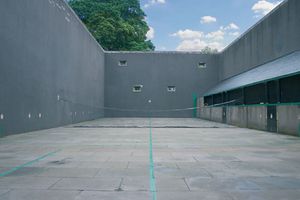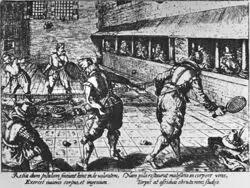How did the modern tennis emerge
Tennis has emerged as a sport that has attracted a strong international following, with many of the world's top players coming from Europe, North American, and Australia. While today's sport is seen as another multi-billion dollar industry with major world tournaments held in many countries, the origins of tennis originate from a game played by monks and elites in Europe's Medieval societies.
Early Origins
While there appears to be some evidence that a ball game akin to tennis existed in the ancient world, specifically ancient Egypt, scholars are not in agreement that this game influenced the modern game. Most of this evidence emerges from words similar to the words tennis and racket. The Romans did play a type of handball game that may have been played in Europe and this game could have remained in memory by the Medieval period, influencing the sport's development. However, few drawings or descriptions indicate what these early games looked like, making it hard to know if there was a clear ancient origin for the sport.[1]
The clearest evidence for the origins of tennis dates to the Medieval period in France at around the 12th century. During this time, a type of court was used where a rope was strung across. The ball would be hit back and forth by hand. The ball was also hit off the surrounding walls and the game likely had various rules. A story emerged during this time that the devil introduced the sport to the order of monks, suggesting perhaps that officials in the church considered this game as a distraction from the monks' main duties. Another Medieval book also questions why archbishops and bishops had taken up the sport.
This book, called Summa de ecclesiasticis officiis, indicates the game that resembled a type of handball had become popular in a number of important churches, advising against the adoption of this game by the clergy. The term tennis appears to originate from a French word meaning "take heed," suggesting the origin of the game is from France.[2]
What became known as "real tennis" emerged in the early 13th century in France. Louis X was known to be a found enthusiast of the handball game of tennis. England also became influenced by the game of tennis. A glove was now sometimes used by this period. The key transformation was the adoption of the game by royal households. Tennis courts were now built on palace grounds rather than in church courtyards. Henry V was the first king in England known to adopt the sport. By the 16th century, a racquet was now used and the oldest surviving tennis court derives from this period, found in Falkland Palace (Figure 1).
During the 16th century, the game of tennis now became even more popular with the royal court in England. Henry VIII was known to have built a tennis court in Hampton Court Palace and played the game. In fact, one of the earliest known games of doubles originated at this time. Henry VIII and Charles V of France played in a match against the Prince of Orange and Marquis of Brandenburg.
The French had developed the game in the 16th century so that a volley, rather than stopping the ball, would be how points would be scored. The rule was the ball can bounce once but not twice; this new rule quickly spread throughout Europe, solidifying this rule for the future. During this time, lines were also added to demarcate boundaries where the ball can land. As tennis gained popularity with the royalty, they encouraged their courts to also play the game, helping to spread its popularity beyond royal families and into the nobility.[3]
Later Developments
By the 17th century, tennis courts began to appear more regularly in cities (Figure 2). London at this time had at least 14 courts. The game by now had spread through most of Europe. However, rising Puritanism in the mid to late 17th century began to diminish the game's appeal in England. In France, during the French Revolution, some began to see tennis as a sport for royalty and should not be played. Although tennis may have somewhat declined during the 18th century, we do now learn more about it.
During this time, depictions of nets are now more evident, indicating it had become a standard part of the game. The basic appearance of tennis, with the use of racquets and nets, had now solidified, although many variations existed in how the game was played.[4]
The next major phase of development occurred in the 19th century when tennis was now able to spread to the masses. During this time, both clay courts and lawn tennis emerged as features of the game. In Victorian Britain, tennis was now seen as a virtuous sport, encouraging its spread in the upper classes. The British Empire now began to also spread the sport to its Asian and other colonies as it was deemed to be a civilized game. At home, the game was seen to be an activity for ladies and gentlemen. Rules were still not standardized by the mid-19th century.
Games sometimes featured two against one player or three players on one side, while court dimensions varied, including hourglass-shaped courts. One important development was by Charles Goodyear, who developed material for tennis balls that gave them a much greater bounce. This helped to make lawn tennis and other surfaces more amenable to the game.[5]

The popularity of the sport led to the creation of clubs and the most significant club to adopt the game was the All England Club in Wimbledon, London. In the 1870s, croquet had become a popular sport in the United Kingdom and the development of lawn tennis made the game suitable in croquet fields. The All England club originally set aside one field for tennis but soon it was tennis that became the more popular sport among the two sports the club supported. By the 1880s, croquet was dropped and the height of the tennis net was standardized now for games in Wimbledon's rule book. The first tournament at Wimbledon, which became the origin of the Wimbledon championships of today, was developed by 1877. The popularity of tennis and the development of tournament play helped now to standardize rules that have remained with us, including how scoring is kept, developing at this time.
The shape of the court also became standardized to its rectangular shape. The rules now largely became the same as the modern game, with the exception of tie breaks not introduced until 1971. The dress, however, was generally more formal, as men wore ties and ladies' long dresses with heels. Women were not allowed to play in the Wimbledon tournament until 1884.[6]
Modern Sport
The surfaces by the late 19th century and early 20th century had now become standardized. Clay, lawn, and concrete courts were now the most common types of surfaces played on. Another major changes occurring were the clothing. For women, their skirts increasingly grew shorter from the 1920s and on, while for the men their clothing became less formal and more conducive for running.[7]
Changes to tennis in the early 1900s mostly relate to the development of tournament play and international tournaments developing. One of these was the Davis Cup that first held its tournament in 1900. By the 1920s, the four major tournaments of that time became the same as those today, with Wimbledon, the US Open, the French Open, and the Australian Open is the most important in tennis. The US open was developed in 1881, the French Open in 1891, and the Australian Open in 1905.[8]
Although in the 19th century the masses began to play tennis more, it was still largely a sport of the upper classes. What changed this was the Great Depression in the 1930s. During this time, public works projects in the United States in particular included building tennis courts in schools and public areas. This helped more people to take up the game of tennis, increasing its popularity. Tournaments were now held not just in exclusive clubs but in other areas as well. The development of professional international organizations paved the way for international tournament play, standardization, and the modern professional game of tennis at international levels. [9] The International Lawn Tennis Federation, later renamed the International Tennis Federation, was developed in 1913. Tennis was featured in the 1924 Olympics, although it did not reappear again until 1984. In 1968, the Open Era began when amateurs and professional athletes competed in the major tournaments.[10] These developments have all led to the mass popularity of the game and the professional tournaments that are still with us.
Conclusion
Today, tennis is arguably one of the most international sports, where almost all countries have tennis courts. The wide adoption of tennis today is in large part due to the spreading of the sport through promotion in the Olympics, television, and the fact the game is relatively easy to play and requires minimal costs. The construction of tennis courts is still common when parks are built, helping to promote the sport to children early on. The sport's increasing levels of prize earning undoubtedly have also helped to make many people take up the sport, where the diversity of players from different countries in major tournaments is the most it has ever been. The exciting and fast-paced nature of the sport also helps the sport's appearance.
Related DailyHistory.org Articles
References
- Jump up ↑ For more information, see: Gillmeister, H. (1998). Tennis: a cultural history. London: Leicester University Press, pg. 3.
- Jump up ↑ For the early Medieval development of the game, see: Bryant, J. E. (2011). Game/Set/Match: A Tennis Guide (Eight Edition). Australia, Belmont, CA: Wadsworth Cengage Learning, pg. 153.
- Jump up ↑ For a history of royal courts playing tennis in the late Medieval period and early Renaissance, see: Guttmann, A. (2004). Sports: the first five millennia. Amherst, Mass.: University of Massachusetts Press, pg. 63.
- Jump up ↑ For details on the 17th and 18th centuries and tennis, see: Baker, W. J. (1988). Sports in the Western world (Rev. ed., Illini books ed). Urbana: University of Illinois Press.
- Jump up ↑ For the history of tennis during the Victorian period, see: Wilson, E. (2014). Love Game: A History of Tennis, from Victorian Pastime to Global Phenomenon. London: Serpent’s Tail.
- Jump up ↑ For the history of late 19th-century development of tennis, rules, and tournaments, see: Bodleian Library. (2010). The original rules of tennis. Oxford: Bodleian Library.
- Jump up ↑ For a history of clothing and tennis equipment, see: Lake, R. (2015). A social history of tennis in Britain. London: New York, NY.
- Jump up ↑ For a history of the major tournaments, see: Collins, B., & Hollander, Z. (1994). Bud Collins’ modern encyclopedia of tennis. Detroit: Gale Research.
- Jump up ↑ For more on how tennis became the sport of different classes, see: Baker, W. J. (1988). Sports in the Western world (Rev. ed., Illini books ed). Urbana: University of Illinois Press, pg. 228.
- Jump up ↑ For history on the International Federation, see: Bowers, C. (2013). The international tennis federation: a century of contribution (1st ed). New York, NY: Rizzoli International Publications, Inc.

